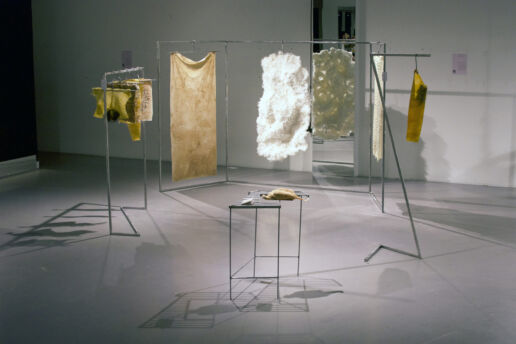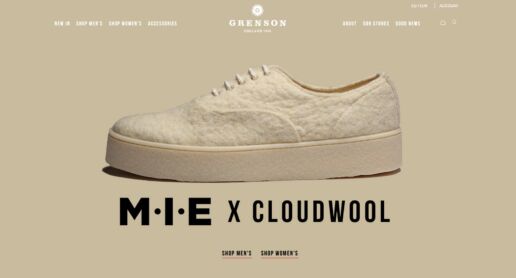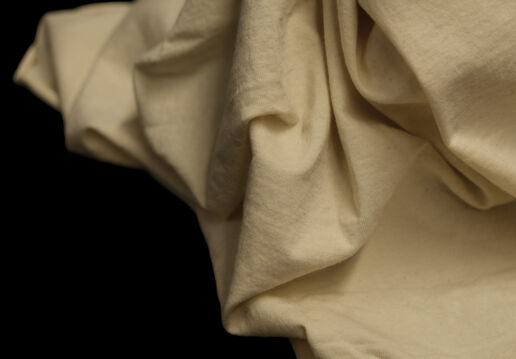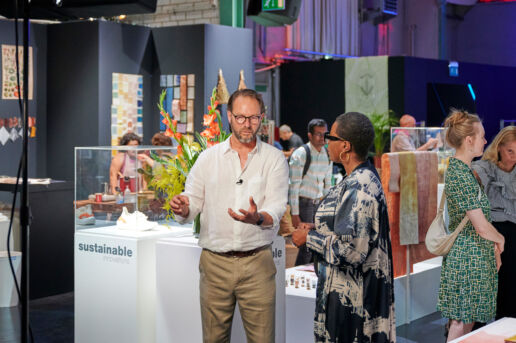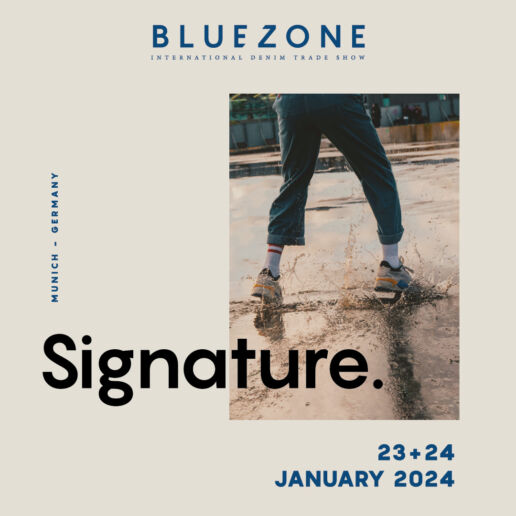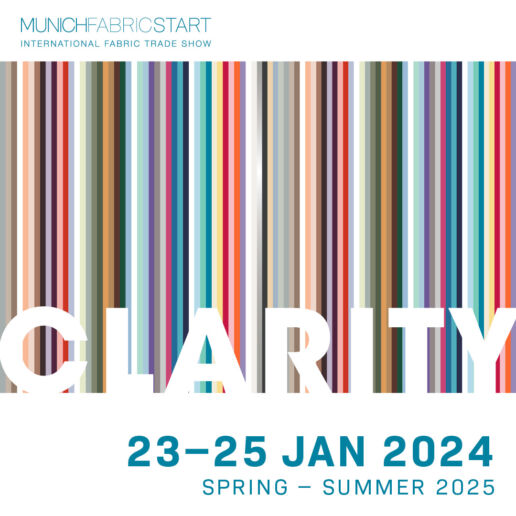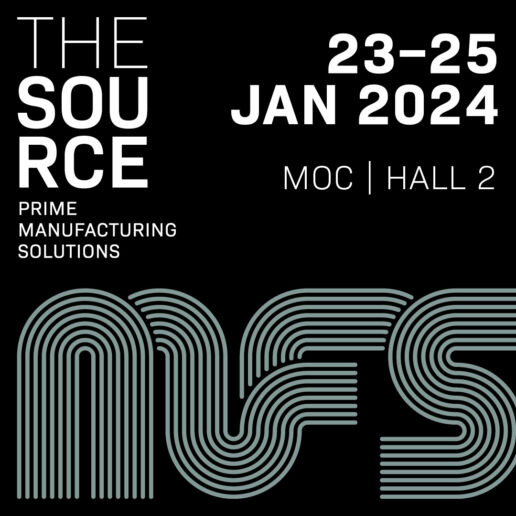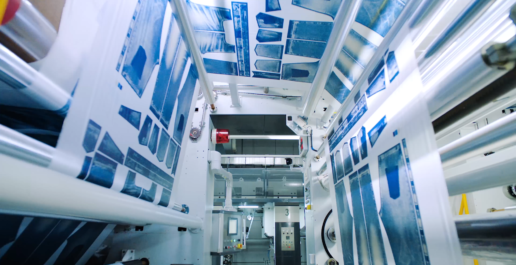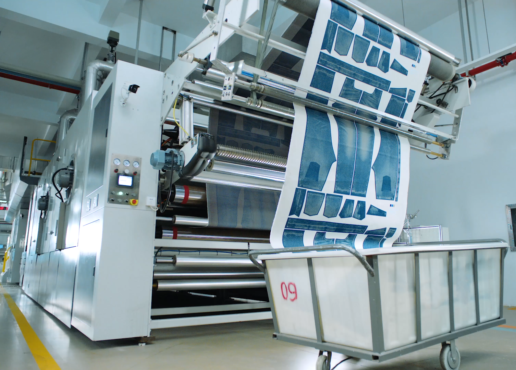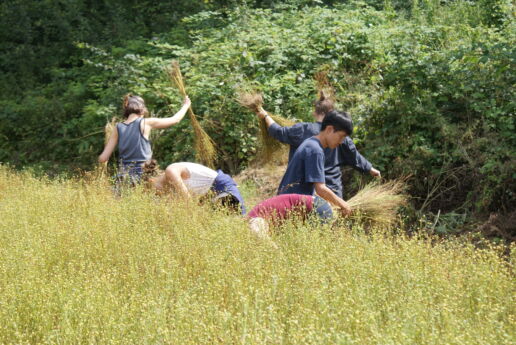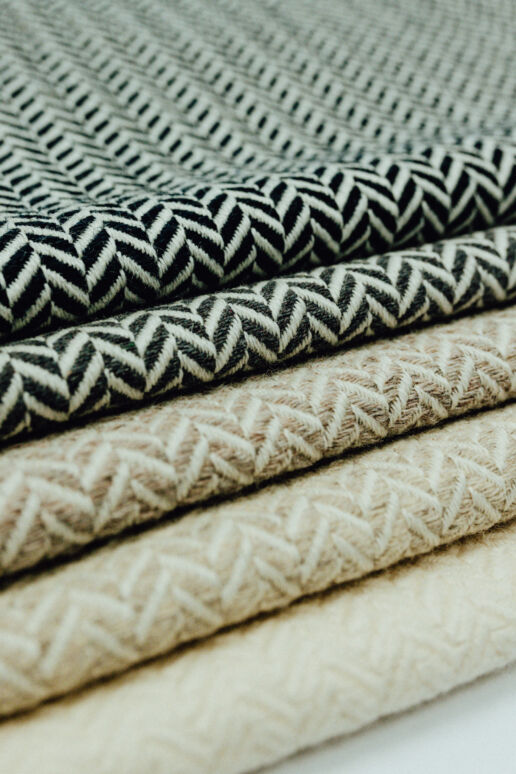Sustainable Innovations
Blooming Minds - Sustainable Innovations
Elizabeth Balado is an artist, designer, and researcher from London, presenting a unique, experientially-driven workshop with her project “Blooming Minds: Social Printing”. Developed over the past year, the workshop combines the psychological and physical benefits of nature with community-based creation, by guiding participants to create their own prints. The workshop encourages participants to follow their own intuition to select and forage flowers and plants and then arrange a composition, before using a technique to transfer the natural dye onto cotton using a mallet.
She will be presenting a variation of the workshop at the KEYHOUSE during Munich Fabric Start, which will consist of participants applying the print technique onto tote bags, allowing them to create and keep their own work. Elizabeth’s research focuses on combining nature – especially the use of natural and recycled materials – and community, a social practice which weaves themes such as mental health while encouraging accessible creativity. Her current work can be found on her Instagram and website. Elizabeth is open to collaboration with foragers, biologists, mental health services and others interested about participating in further printing workshops.
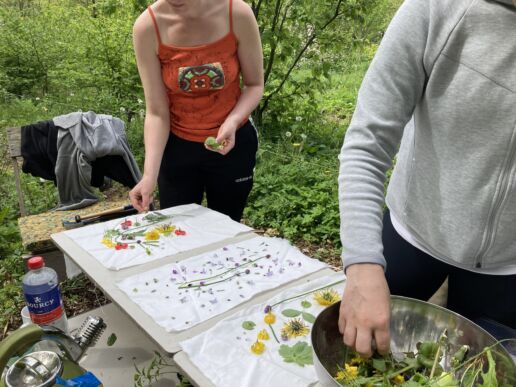
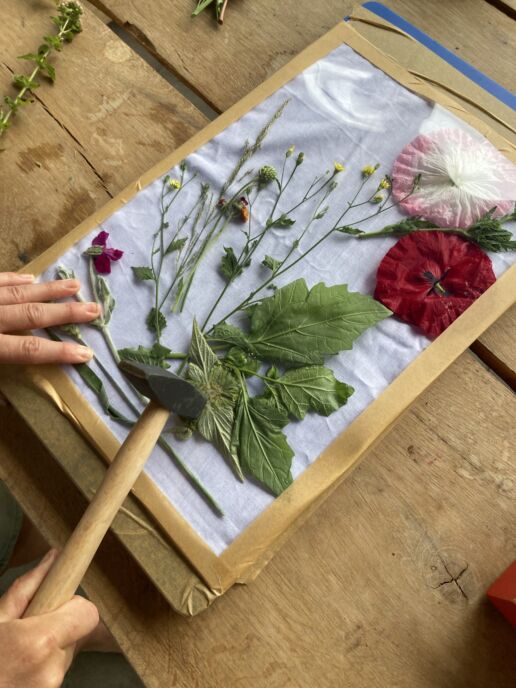
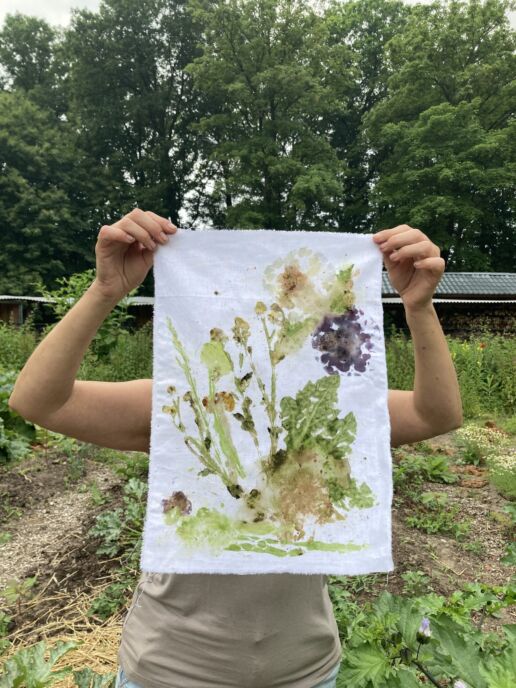

———————————————————————–
THIS MIGHT BE ALSO INTERESTING FOR YOU
New Fabric Collection by Paulo de Oliveira
13. December 2024
Paulo de Oliveira is a reference in sustainable production, focusing on sustainable raw materials produced in Europe by ecological processes.
SPRING.SUMMER 26 FABRIC HIGHLIGHTS & MATERIAL NOVELTIES – PART I
12. December 2024
Fashionable woven and knitted fabrics made of wool, cotton, silk, blends and functional fibres are presented by our international suppliers..
MUNICH FABRIC START & BLUEZONE – Essential and efficient
5. September 2024
INTUITION means that we have the courage to rely on our inner voice instead of just relying on hard facts and data. An interview with the organisers of MUNICH FABRIC START.
Being Plucked - Sustainable Innovations
Suzanne Corcessin’s “Being Plucked” (“Être à Fleur de Peau”) utilizes unconventional textiles to argue against the notion that bird plucking and hair removal are neutral actions. Suzanne Corcessin views these acts as political, maintaining colonial and gendered hierarchies. Through bird plucking and the aesthetics of hair removal, bodies historically have been controlled and objectified.
The installation employs latex, textiles, silicone, and feathers to create textures that confront viewers with conflicting emotions, provoking new perspectives on the debate over hair removal. In this everyday decision and product debate, the question arises: Who decides what is right or wrong, beautiful or unattractive?
“Being Plucked” questions underlying assumptions and illuminates the political dimensions of decisions about one’s body. By creating textiles that evoke discomfort, Suzanne Corcessin urges a shift in the perception of the act of hair removal, breaking through the colonial and gendered structures often associated with this topic.
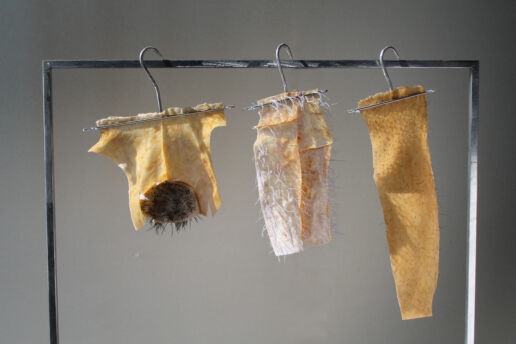
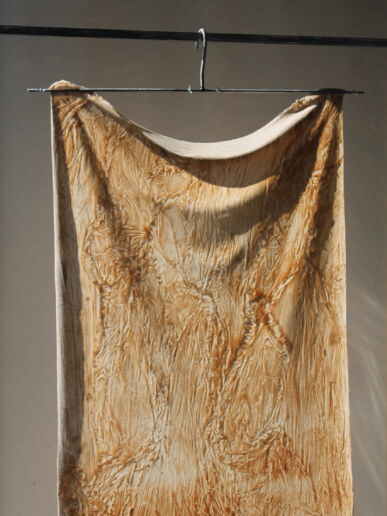
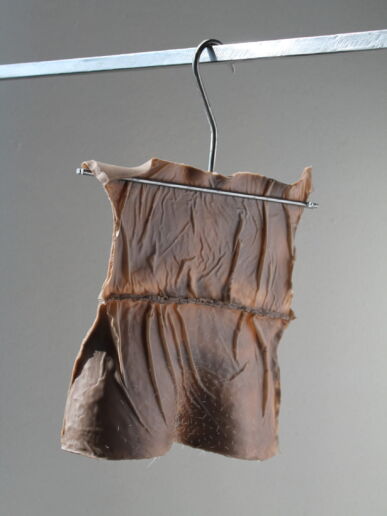
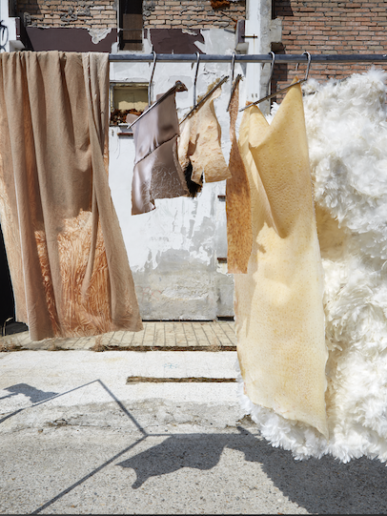
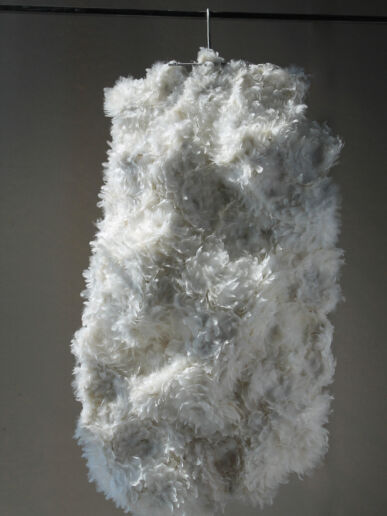
———————————————————————–
THIS MIGHT BE ALSO INTERESTING FOR YOU
New Fabric Collection by Paulo de Oliveira
13. December 2024
Paulo de Oliveira is a reference in sustainable production, focusing on sustainable raw materials produced in Europe by ecological processes.
SPRING.SUMMER 26 FABRIC HIGHLIGHTS & MATERIAL NOVELTIES – PART I
12. December 2024
Fashionable woven and knitted fabrics made of wool, cotton, silk, blends and functional fibres are presented by our international suppliers..
MUNICH FABRIC START & BLUEZONE – Essential and efficient
5. September 2024
INTUITION means that we have the courage to rely on our inner voice instead of just relying on hard facts and data. An interview with the organisers of MUNICH FABRIC START.
Revoltech - Sustainable Innovations
Lucas Fuhrmann, the visionary behind Revoltech, inaugurates a transformative era of presentation technology that amalgamates nature, technology, and sustainability. Through innovative light columns, he creates unique experiences that not only impress aesthetically but also underscore Revoltech’s
commitment to transparency and eco-friendliness.
The revolution of Revoltech lies in the use of Hemp-Leder, an advanced fusion of hemp fibers and traditional leather. This sustainable material choice reflects Revoltech’s endeavor to promote environmentally friendly and ethical practices. The physical location of Revoltech at Darmstadt, is not just a hub of progress but also a symbol of innovation and design.
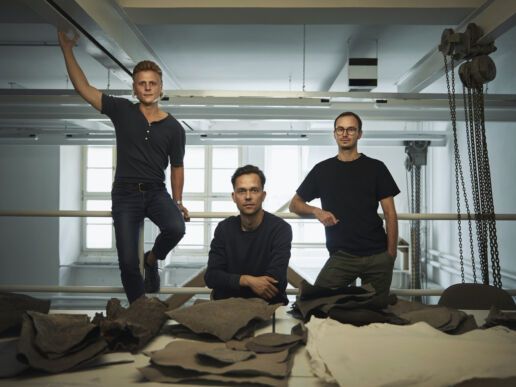
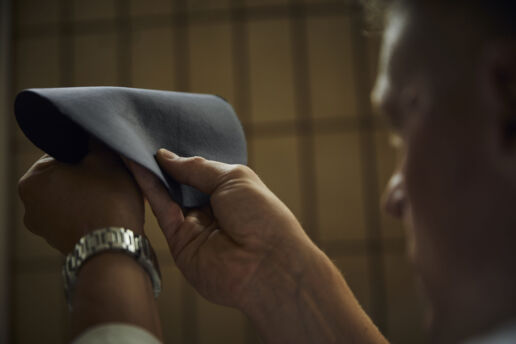
Revoltech is changing the rules of the textile industry with LOVR, a revolutionary material marking the beginning of a sustainable textile revolution. LOVR, based on hemp remnants, is entirely recyclable and biodegradable, with no plastic components. With a minimal ecological footprint, LOVR can be produced carbon-neutral, finding versatile applications in furniture, fashion, and the automotive industry.
Revolutionizing the way materials are made is Revoltech’s mission. Their story began in 2021 as a spin-off from TU Darmstadt, driven by the belief that the textile industry needs a transformation. With LOVR, they make a clear statement for sustainable innovation and a future without compromises.
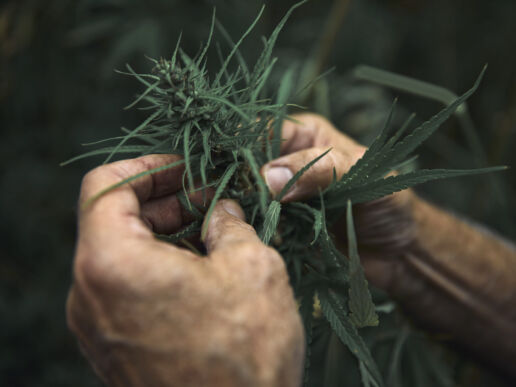

———————————————————————–
THIS MIGHT BE ALSO INTERESTING FOR YOU
New Fabric Collection by Paulo de Oliveira
13. December 2024
Paulo de Oliveira is a reference in sustainable production, focusing on sustainable raw materials produced in Europe by ecological processes.
SPRING.SUMMER 26 FABRIC HIGHLIGHTS & MATERIAL NOVELTIES – PART I
12. December 2024
Fashionable woven and knitted fabrics made of wool, cotton, silk, blends and functional fibres are presented by our international suppliers..
MUNICH FABRIC START & BLUEZONE – Essential and efficient
5. September 2024
INTUITION means that we have the courage to rely on our inner voice instead of just relying on hard facts and data. An interview with the organisers of MUNICH FABRIC START.
A Life As An Art Project - Sustainable Innovations
To artist Sophie Conroy, her life is an experiment. In her latest work, she chose to live without her own house for 6 months in Eindhoven, on a quest to find more connected ways of living. During this time, she experienced living amidst chaos and connection. She found various forms of shelter and witnessed the beauty of her community. Through observing her fundamental human needs, she aims to grasp their authentic essence. Embracing the discomfort of houselessness allowed her to uncover valuable insights, challenging traditional notions of art, ownership, and community.
Textiles, for Sophie, become a medium that provides protection while revealing the vulnerability of the self. Confronting existential challenges during her houselessness, textiles transform into symbols of resilience and self-discovery.
Sophie crafts her textiles using primarily found materials, notably her own clothing. She believes in the power of textiles as a communication tool, using them to capture the essence of community and home. She peels away the capitalist consumer dimension of fabric, recognising it as a fundamental connection between body and environment.
Sophie Conroy doesn’t just create artworks; she constructs spaces for dialogue and interaction. Her installations incorporate videos, tapestries, drawings, writing and projections, creating a captivating fusion of textiles and visual art. The space and Sophie herself become part of the art, inviting observers to immerse themselves in this interactive environment.
Sophie emphasises that our focus should not be on designing more ‘stuff’ but on creating new perspectives and ways of seeing. Through creating tools to shift our perspectives, Sophie believes we can move away from the current patterns of exploitation, isolation, and consumption and towards societies grounded in trust, joy, and connection.
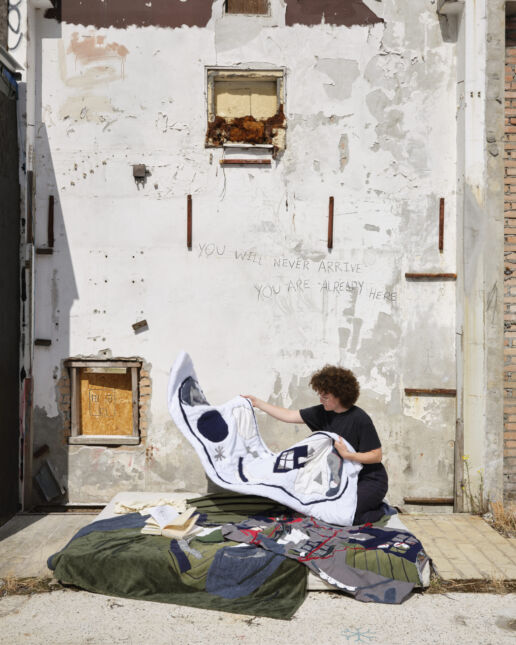
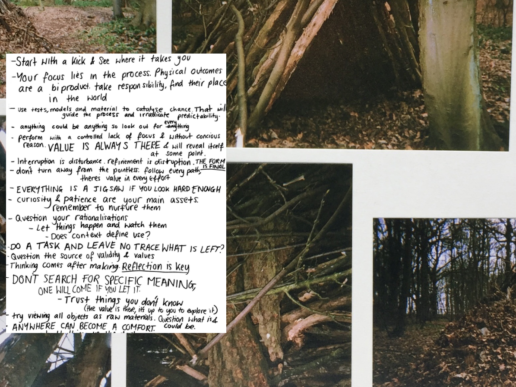
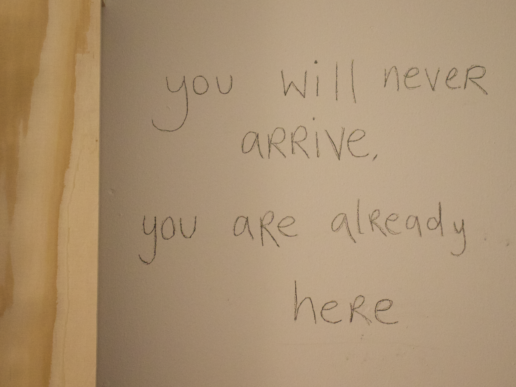
———————————————————————–
THIS MIGHT ALSO BE INTERESTING FOR YOU
New Fabric Collection by Paulo de Oliveira
13. December 2024
Paulo de Oliveira is a reference in sustainable production, focusing on sustainable raw materials produced in Europe by ecological processes.
SPRING.SUMMER 26 FABRIC HIGHLIGHTS & MATERIAL NOVELTIES – PART I
12. December 2024
Fashionable woven and knitted fabrics made of wool, cotton, silk, blends and functional fibres are presented by our international suppliers..
MUNICH FABRIC START & BLUEZONE – Essential and efficient
5. September 2024
INTUITION means that we have the courage to rely on our inner voice instead of just relying on hard facts and data. An interview with the organisers of MUNICH FABRIC START.
CLOUDWOOL - Sustainable Innovations
Cloudwool, presented by Martin Brambley, is an oasis of sustainability in the textile universe, introducing pure, local wool of new quality to the market. The projects name symbolises not just an island in the sky but also the unity of environmentally conscious production and high-quality materials.
In a time where natural wool is often imported and blended with synthetic fibers, Cloudwool relies on local resources and fights against the neglect of local sheep farmers’ wool. The sustainable angle of Cloudwool emerges from the desire to bring local fibers to the market in new and exciting forms. The 100% local wool, typically considered waste, is transformed into a super-soft and durable fabric through nonwoven technology – without burdening the environment. Natural, breathable, and comfortable, Cloudwool integrates the natural properties of wool into the material to make it as exceptional as possible.
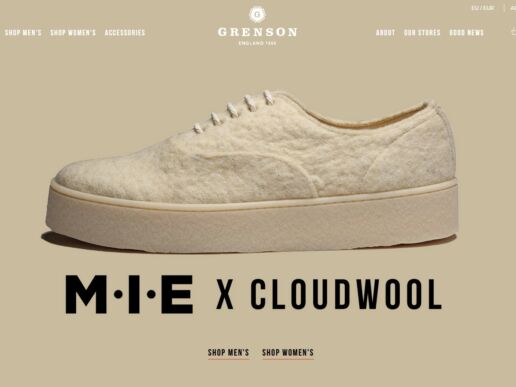
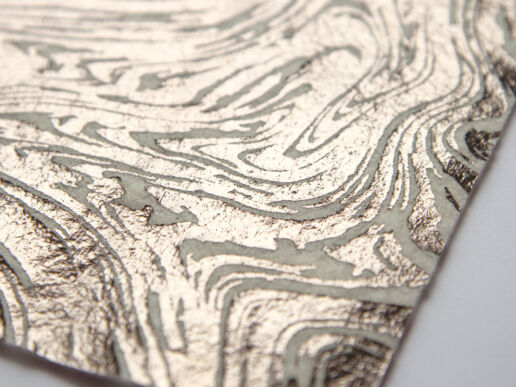
From farm to fabric, Cloudwool relies on local resources, creating a traceable supply chain in collaboration with European sheep farmers. The company pays farmers up to 5 times more than the market price for their wool and produces Cloudwool locally using energy-efficient processes. Together with Cloudwool, you’re not just shaping clothing but also reshaping silhouettes and textures. This isn’t just ordinary wool fabric – with more personality and far fewer post-processing possibilities, the potential is endless.
Doppelhaus, the company behind Cloudwool, was founded by Martin Brambley and Yolanda Leask. In a world where sustainable fashion must be affordable, they are committed to creating sustainable materials for a circular, low-carbon fashion industry of the future. Their innovative approach utilizes efficient nonwoven textile production techniques in line with Cradle-to-Cradle principles.
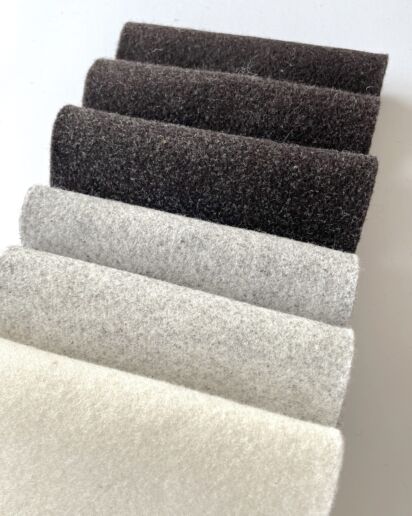
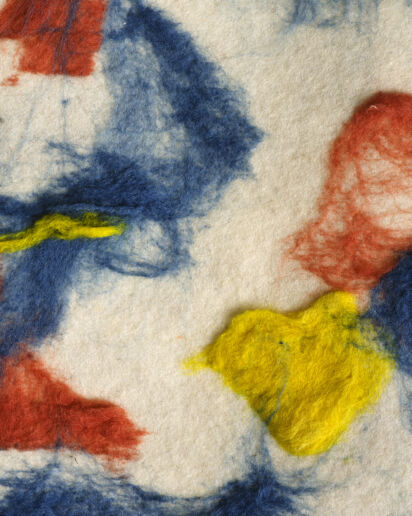
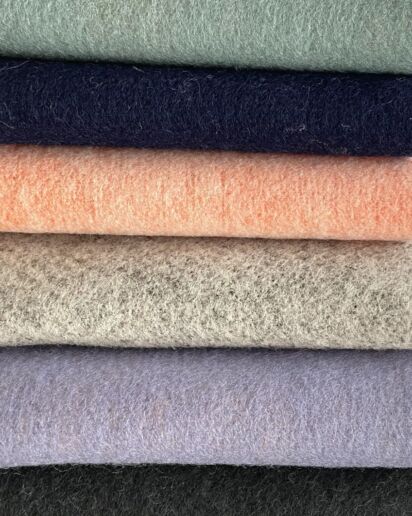
———————————————————————–
THIS MIGHT BE ALSO INTERESTING FOR YOU
New Fabric Collection by Paulo de Oliveira
13. December 2024
Paulo de Oliveira is a reference in sustainable production, focusing on sustainable raw materials produced in Europe by ecological processes.
SPRING.SUMMER 26 FABRIC HIGHLIGHTS & MATERIAL NOVELTIES – PART I
12. December 2024
Fashionable woven and knitted fabrics made of wool, cotton, silk, blends and functional fibres are presented by our international suppliers..
MUNICH FABRIC START & BLUEZONE – Essential and efficient
5. September 2024
INTUITION means that we have the courage to rely on our inner voice instead of just relying on hard facts and data. An interview with the organisers of MUNICH FABRIC START.
CO2 Tex - Sustainable innovations
Within the BIOTEXFUTURE cluster, the CO2Tex project introduces innovative paths for sustainable elastic yarns. In the context of the overarching BIOTEXTFUTURE project, the Institute for Textile Technology (ITA) and the Chair for Technology and Organizational Sociology (STO) at RWTH Aachen, together with adidas, strive to achieve the transition of the entire textile value chain to bio-based materials.
CO2Tex stands out as a central project within BIOTEXFUTURE, focusing on CO2-containing thermoplastic polyurethane (TPU) as an alternative to conventional elastane. This project revolutionizes elastic yarn production by eliminating toxic solvents, not only reducing environmental impact but also enabling potential industrial mass production.
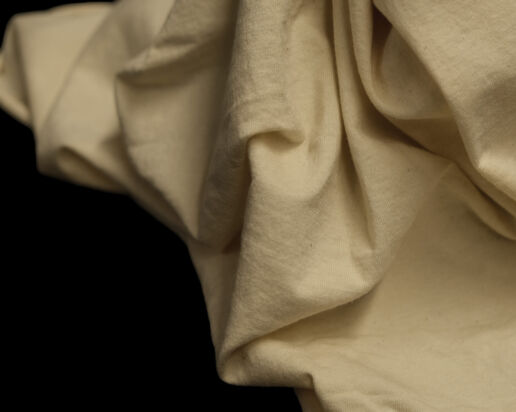
The overarching BIOTEXFUTURE project, led by ITA, STO, and adidas, aims for a swift translation of fundamental research into practical applications. Traditional textiles are to be replaced by sustainable, biobased materials, with CO2Tex playing a pivotal role by demonstrating advancements in the development of commercially viable elastic filament yarns from CO2-containing TPU.
CO2Tex’s goal by October 2024 is to establish these environmentally friendly yarns on an industrial scale, replacing conventional elastane. The project not only focuses on technological advancements but positions itself as a pioneer for sustainable development across the textile industry. By integrating CO2Tex into BIOTEXFUTURE, the vision of an eco-friendly and bio-based future in the textile industry takes a significant step forward.
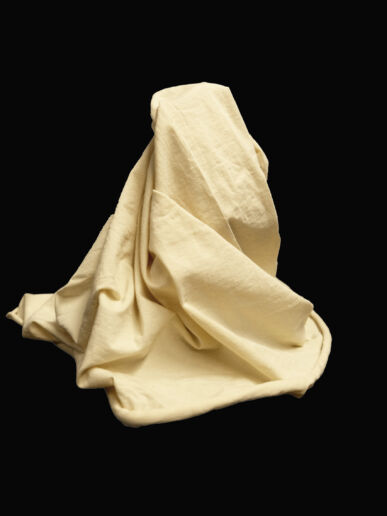
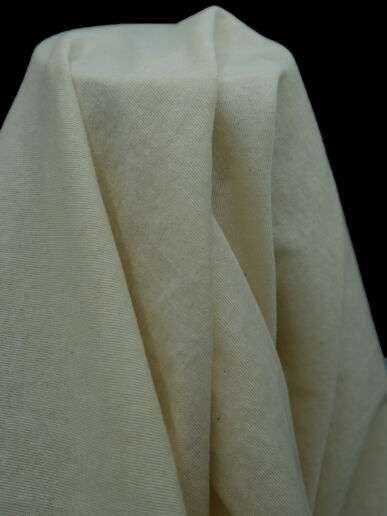
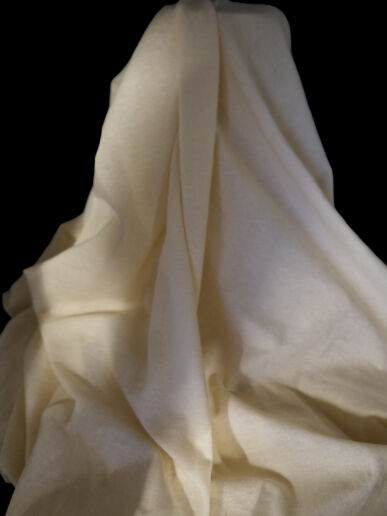
———————————————————————–
THIS MIGHT BE ALSO INTERESTING FOR YOU
New Fabric Collection by Paulo de Oliveira
13. December 2024
Paulo de Oliveira is a reference in sustainable production, focusing on sustainable raw materials produced in Europe by ecological processes.
SPRING.SUMMER 26 FABRIC HIGHLIGHTS & MATERIAL NOVELTIES – PART I
12. December 2024
Fashionable woven and knitted fabrics made of wool, cotton, silk, blends and functional fibres are presented by our international suppliers..
MUNICH FABRIC START & BLUEZONE – Essential and efficient
5. September 2024
INTUITION means that we have the courage to rely on our inner voice instead of just relying on hard facts and data. An interview with the organisers of MUNICH FABRIC START.
Diversity in Dynamics
Marvelling at the levels of sophistication and innovation modern fabrics have attained and continue to breach, it is easy to forget that our relationship with textiles is one of the most intimate and primal ones we have. Granted, today’s creations are (thankfully) far removed from the scratchy cloth our ancestors wore huddled around the fire.
But over the course of time, our relationship with textiles has changed. While we have – technically and commercially – never been closer to textiles, ambitiously engineering fabric compositions to cater to an increased demand of sustainability, for instance, we are ironically also stepping further away emotionally from what was once – literally – closest to us. Today, our engagement with textiles is largely dependent on the prism through which we choose to experience and value it:
We have increasingly come to approach textiles as objects of research and science, questioning what characteristics new fabrics ought to have and how existing textiles can be improved to comply with the ever-changing demands of the market. Impressive examples of such science-led approaches are two projects within the BIOTEXFUTURE-cluster, led by the Institute for Textile Technology (ITA) and the Chair for Technology and Organizational Sociology (STO) at RWTH Aachen together with their industry partner adidas. Within BIOTEXFUTURE, they investigate the transition of the textile value chain to bio-based materials, including alternatives to conventional elastane (CO₂Tex), or the establishment of bio-based polymers in the industry (BIOBASE).
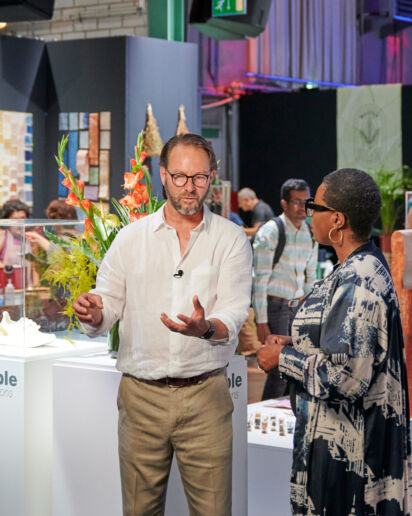
Of course, textiles also lend themselves to in-depth material exploration, analysing intricacies of production and means of (p)rethinking and challenging standards. Think of leather and its unique characteristics – who would have thought something strikingly similar could be crafted from a hemp plant, as illustrated by Lucas Fuhrmann’s “Revoltech”? Or going so far as to almost brutally decontextualize a biomaterial like feathers from their original purpose of insulation, submitting it completely to the functionality of aesthetics, as Suzanne Corcessin has done with “Being Plucked”.
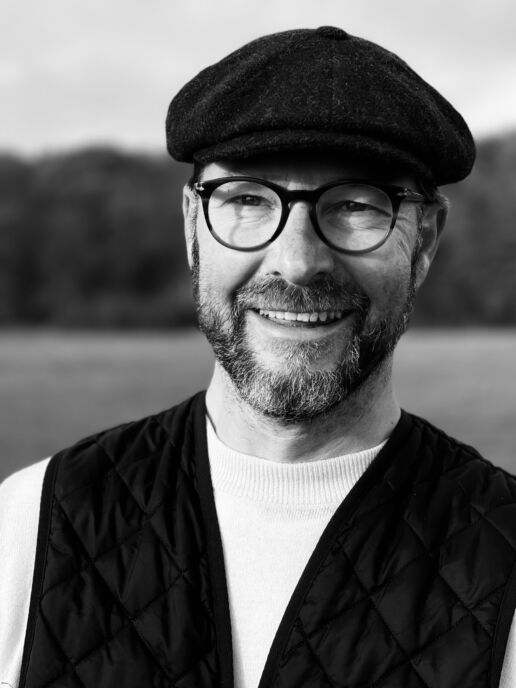
Simon Angel
And still, textiles can be a means of social connection – looking at the emotional component of fabrics, their functionality and the effects they have on others in public and private interaction, reconstructing relationships and the marriage between human and textile. Beautiful testaments of such exploration are the works of Paul Schaffer, whose collection of woven fabrics aims to foster appreciation for the interconnectedness of organisms, Sophie Conroy, who investigates the metaphysical significance of textiles as a connection between the body and the environment, and Elizabeth Balado’s “Blooming Minds: Social Printing”.
Are we leading or following completely different dynamics? Are we at risk of sacrificing artistic intimacy for scientific progress? Are we winning or losing touch? It’s not about being right or wrong, but a question of prism. The Sustainable Innovations Forum proves that it is possible to navigate these different dynamics. Take Cloudwool, for example: with a diverse portfolio and numerous opportunities to work with their product, they have attracted the attention of the likes of Grenson and Balenciaga, effectively demonstrating that it IS possible to unite the different dimensions of soul and science, while successfully positioning their product at the same time.
Feel the difference in dynamics for yourself – come and meet us in the KEYHOUSE and experience the Sustainable Innovations Forum.
Best wishes,
Simon
INFORM & INSPIRE YOURSELF AT THE MUNICH FABRIC START
IN THE SUSTAINABLE INNOVATIONS AREA IN THE KEYHOUSE – H5!
Discover more industry-changing innovations at our upcoming trade fairs:
STELLA BLU PRESENTS ITS FIRST COOLTRANS DENIM COLLECTION MADE WITHOUT INDIGO
Stella Blu is very proud to announce to be the first Denim mill in the world to adopt the use of NTX Cooltrans – the revolutionary waterless coloration technology into its production of denim & colored denim fabrics.
The coloration process happens with extreme precision and consistency every time and is applicable to almost any fabrics, natural, cellulose-based or synthetics man-made without the need for heat and over 90% reduction in water usage without compromising the fabric’s engineered feel or functional performance.
Conventional denim has an extensive use of water, heat and chemicals starting from the initial processes of fabric making – dyeing yarns into several indigo baths – all the way down to laundry processes to create that vintage distressed look.
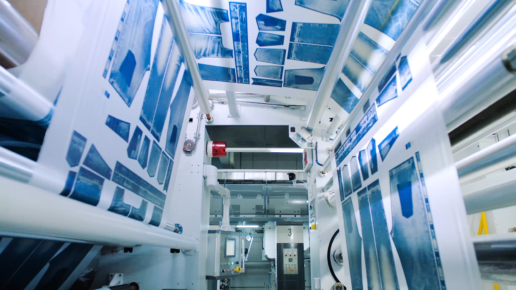
“With Cooltrans, we are able to completely eliminate these two processes.”, says Marco Stefanelli, director of marketing & business development at Stella Blu. “We start from a white PFD fabric and then the coloration process happens without heat at both sides simultaneously in only one single pass—the front face gets the printed washed look and the back side face gets printed with the twill line or any other pattern the client’s desire.”
This technology opens up extremely exciting possibilities. For instance, clients could have a single quality greige and print nearly infinite combination of aesthetics. By doing so, they can drastically improve the speed to market with much lower SKUs.
Many denim brands today maintain extensive material libraries, consisting of well over 500 different types of fabric, solely for the purpose of achieving a desired look. However, with Cooltrans, the aesthetic can be completely independent of the fabric composition. By calibrating the process to a specific fabric base, brands can achieve a wide range of aesthetics on a single twill type, resulting in tremendous costs savings.
Furthermore, addressing the environmental impact of indigo dye is a shared concern within the industry. Cooltrans is seen as a promising solution to reduce the toxicity associated with indigo dye as there is no indigo involved in the entire process, which is an additional key point that many brand houses view it favourably.
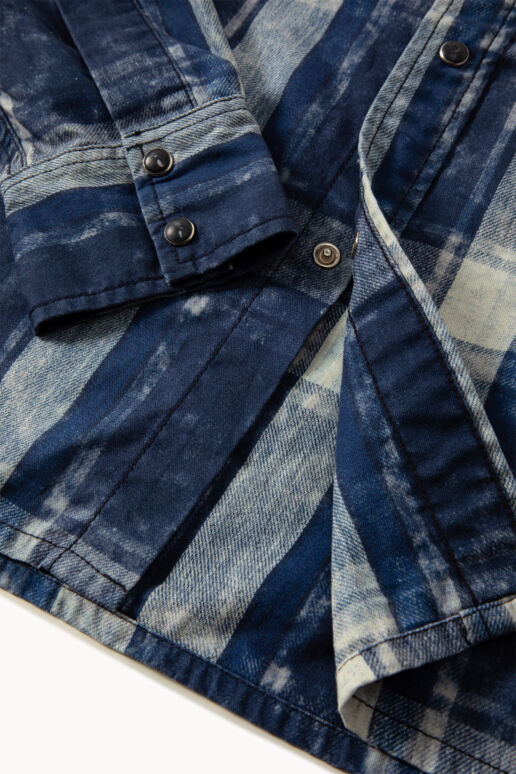
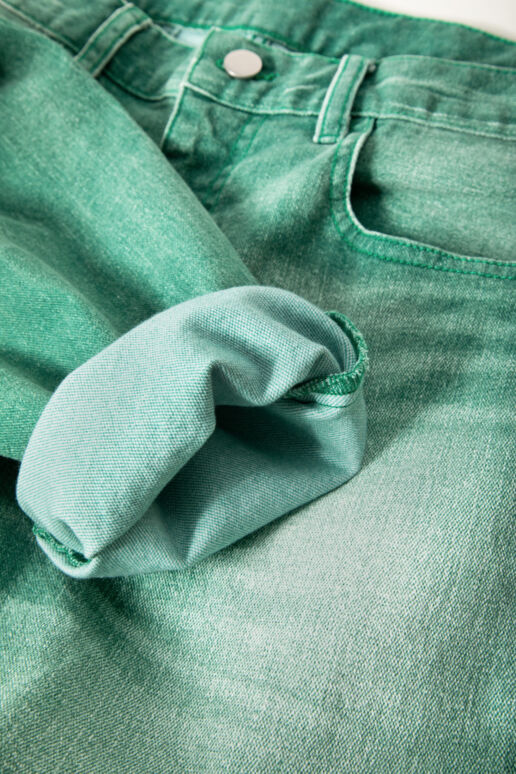
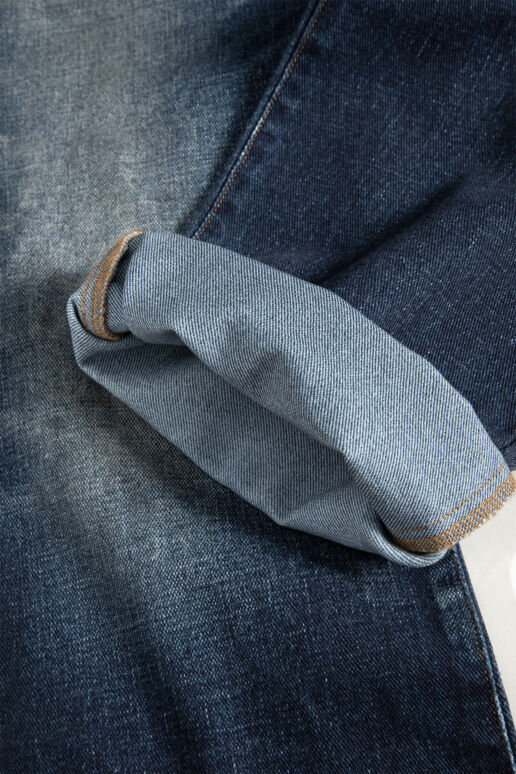
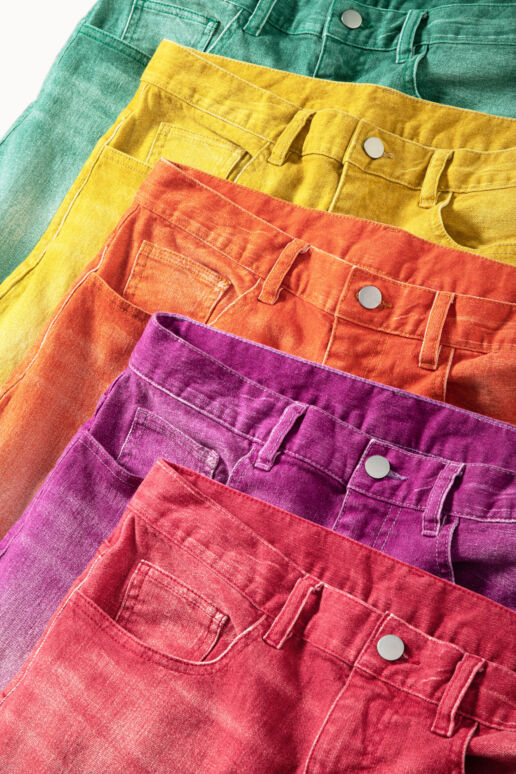
Meet the Stella Blu Team at Bluezone in Hall 7 | B 16.
This might be also interessting for you:
FABRIC HIGHLIGHTS & MATERIAL NOVELTIES FOR AUTUMN.WINTER 25/26 – PART VI
1. September 2024
Manifattura di Carmignano is more than a textile company: it is a core group of people united by a passion for excellence and an unwavering commitment to sustainability.
KEYHOUSE NEWS – MOMENTUM
1. September 2024
Momentum plays a crucial role by providing the technology to create and manage these digital passports for fashion brands & suppliers ensuring compliance and fostering circular product development.
Cartoon – Fashion for courage, joie de vivre and self-realisation
1. September 2024
Cartoon sweeps through the fashion world with a fresh breeze of optimism, bringing colour not only to the wardrobe but also to everyday life.
Sustainable Innovations – Suzanne Oude Hengel
31. August 2024
Suzanne's goal: to push boundaries, experiment, and challenge the way things are done.
The Source Collection’s News: EAST
31. August 2024
Fashion is not only about following trends, but also about expressing your creativity and personality.
BLUEZONE NEWS FOR SEPTEMBER 2024 – PART III
30. August 2024
A company with a sustainable growth vision, Sharabati Denim is a pioneer in the region when it comes to environmental awareness.
KEYHOUSE NEWS – Centric Software
30. August 2024
Having Centric in place saves everyone about 10-15 percent of their time on a day to day basis, mainly because people don’t have to spend time searching for the right answers, asking questions and re-confirming whether information is up to date
Sustainable Innovations – Studio Joris de Groot
30. August 2024
“The factory is my playground, searching for new possibilities with the tools I can find.”
FABRIC HIGHLIGHTS & MATERIAL NOVELTIES FOR AUTUMN.WINTER 25/26 – PART V
29. August 2024
RE/UPcycle Alpaca is characterised by its commitment to sustainability and environmental responsibility at every stage of the design and manufacturing process.
Additionals Trends Autumn.Winter 25/26 – Part 4
29. August 2024
valupa employs a combination of 3D printing and injection molding in their design and production processes to reduce waste and avoid faulty production.
A cultural heritage - Sustainable Innovations
Flax was traditionally grown as a crop in the Netherlands, and Dutch linen was one of the most sought-after for a long time because of its good quality. Today that is no longer the case. Therefore, in 2018, Crafts Council Nederland, in cooperation with the Fashion Design Master of ArtEZ University, initiated ‘The Linen Project’ to revive the economic viability of local flax cultivation and linen production in the Netherlands, while transforming it in a sustainable way.
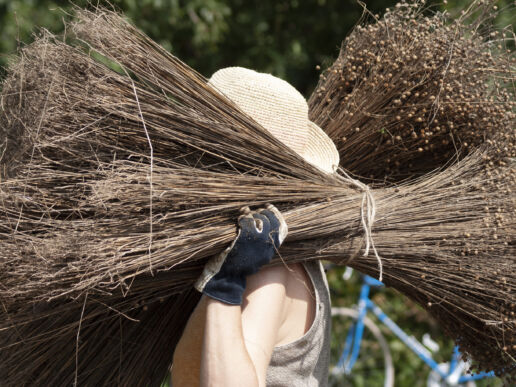
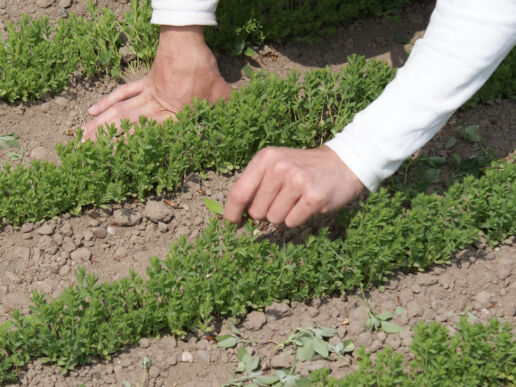
The Linen Project aims to change and challenge thinking in a multidisciplinary way across fields and sectors – agriculture, history, heritage, (landscape)
architecture, fashion, food, crafts, design, contemporary art, economics, innovative business. After all, the whole world is changing. On the one hand, people are more digitally connected to each other than ever before. But at the same time, there is a growing interest in connecting to the products we use and consume every day and how they are made. How and where are our roots? How can we reconnect with deep human values and ancient knowledge and skills? The Linen Project explores the tradition of linen production in the Netherlands and drives the exchange of different values, knowledge, skills and competences across industry boundaries.
Learning by doing is the motto of the project: prototypes of new economic, social and cultural ecosystems are created in a dynamic environment, demonstrating the vital importance of (biological) diversity. The production process involves only four steps – the flax from 2019, for example, was grown on the Lingehof near Arnhem (NL), mechanically processed by Van de Bilt Zaden en Vlas in Sluiskil (NL), spun in Poland and woven into linen by Enschede Textielstad in Enschede (NL). In the process, “old” knowledge meets new technologies, so that future production is based on and builds on a restored connection between people and nature.
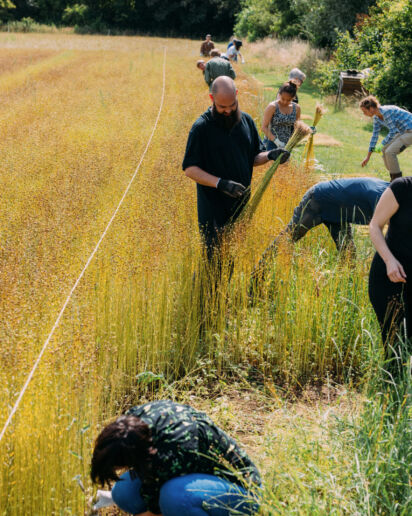
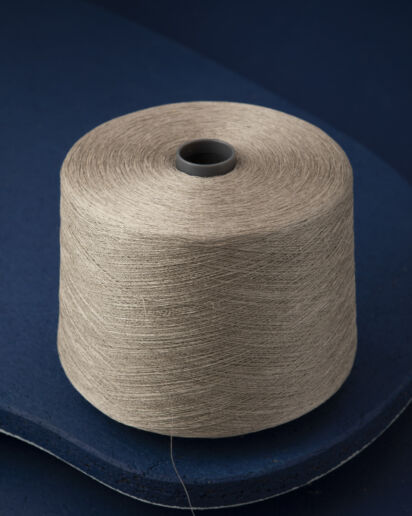
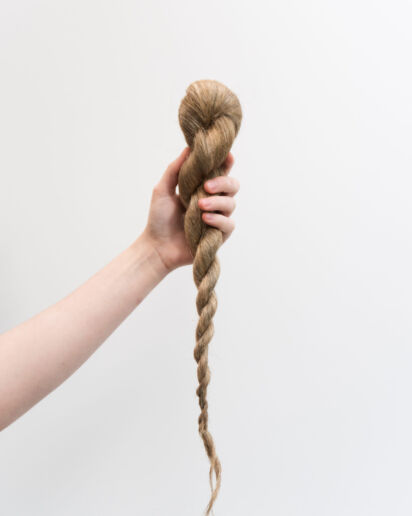
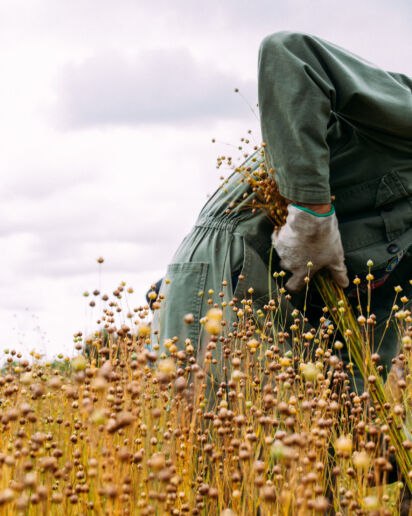
“The Linen Project is our collaborative effort to understand the making of local textiles and experience the beauty of it. This is a shared journey where we, learning by doing, rediscover our relationship with nature and each other.”
WILLEMIEN IPPEL, CO-FOUNDER CRAFTS COUNCIL NEDERLAND
———————————————————————–
THIS ALSO MIGHT BE INTERESTING FOR YOU
New Fabric Collection by Paulo de Oliveira
13. December 2024
Paulo de Oliveira is a reference in sustainable production, focusing on sustainable raw materials produced in Europe by ecological processes.
SPRING.SUMMER 26 FABRIC HIGHLIGHTS & MATERIAL NOVELTIES – PART I
12. December 2024
Fashionable woven and knitted fabrics made of wool, cotton, silk, blends and functional fibres are presented by our international suppliers..
MUNICH FABRIC START & BLUEZONE – Essential and efficient
5. September 2024
INTUITION means that we have the courage to rely on our inner voice instead of just relying on hard facts and data. An interview with the organisers of MUNICH FABRIC START.
Cooperation is key - Sustainable Innovations
Local and recycled: Enschede Textielstad was founded in 2013 by Annemieke Koster to create responsibly produced fabrics from recycled yarns and local raw materials such as flax, hemp and wool for apparel and interior textiles. To keep the supply chain as short and regional as possible, one of the main focuses of the concept is to develop smart and circular uses of waste streams and local resources – for example, Dutch wool. Its quality is not good enough to make clothes from, and to date there has been no viable business model in sight for this resource – so it has been burned. However, what is not good enough for clothing may be absolutely sufficient for other purposes, so Enschede Textielstad now weaves fabrics from the wool that are ideal for upholstered furniture.
The same applies to linen – there have been no projects with economic viability in the Netherlands to date. To change this, The Linen Project was founded in 2019 as an initiative of Crafts Council Nederland and ArtEZ University of Fine Arts (see feature in also this Sustainable Innovations issue). In 2020, the two projects began a collaboration based on division of labor, with Enschede Textielstad acting as a weaving mill for flax cultivated in the Netherlands.
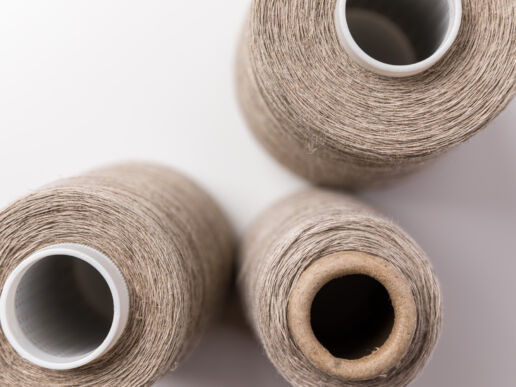
“We are bridging the gap between mass production and laboratory scale testing. We do so with a focus on sustainable, local and social production on the most innovative machine the industry has to offer. With our investment and expertise we help the industry move forward by testing new materials in early stages of development.”
ANNEMIEKE KOSTER, FOUNDER ENSCHEDE TEXTIELSTAD
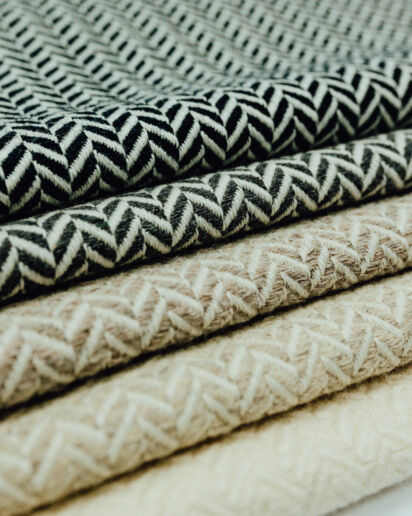
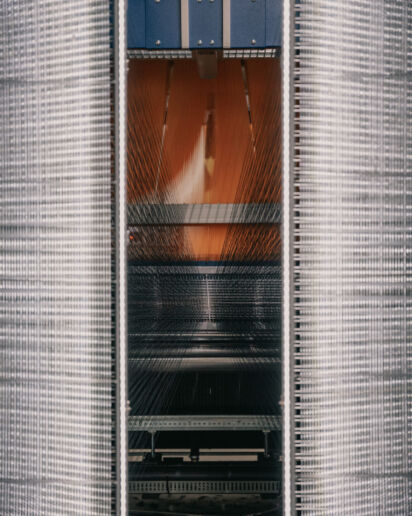
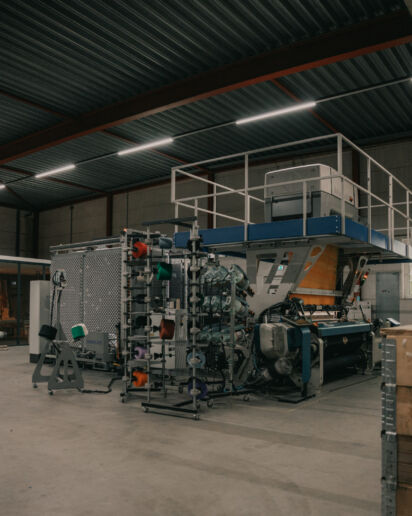
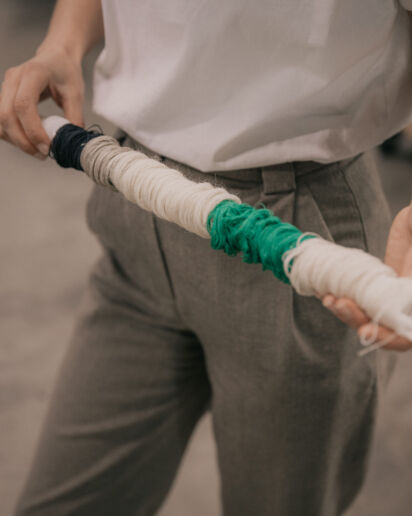
This collaboration is accompanied by a new cooperative business model: instead of simply selling the fabric by the meter to customers, a subscription model was designed for The Linen Project. Customers become part of the supply chain and share responsibility for the process of harvesting, weaving and finishing. The fabrics are then sold as “lots”, with all the imperfections as these are part of the subscription.
———————————————————————–
THIS MIGHT ALSO BE INTERESTING FOR YOU
New Fabric Collection by Paulo de Oliveira
13. December 2024
Paulo de Oliveira is a reference in sustainable production, focusing on sustainable raw materials produced in Europe by ecological processes.
SPRING.SUMMER 26 FABRIC HIGHLIGHTS & MATERIAL NOVELTIES – PART I
12. December 2024
Fashionable woven and knitted fabrics made of wool, cotton, silk, blends and functional fibres are presented by our international suppliers..
MUNICH FABRIC START & BLUEZONE – Essential and efficient
5. September 2024
INTUITION means that we have the courage to rely on our inner voice instead of just relying on hard facts and data. An interview with the organisers of MUNICH FABRIC START.





